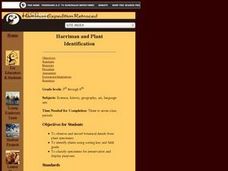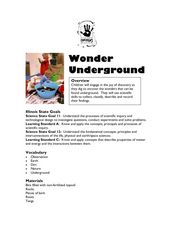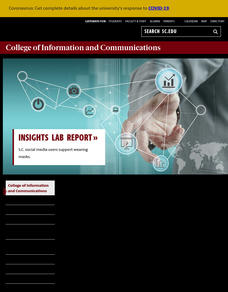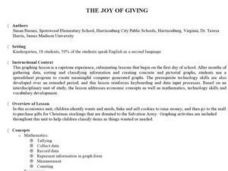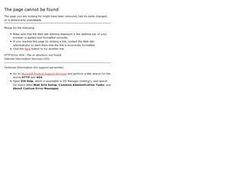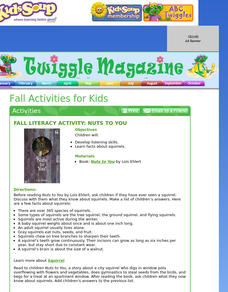Curated OER
Valentine's Day Math
First graders sort their candy hearts into piles according to color and record a tally mark under the color for each candy heart that they have on the worksheet. They then record the total amount of tally marks for each color of candy...
Curated OER
2nd Grade - Act. 17: Source Relay
Help your 2nd graders understand the difference between natural and man-made materials. They will sort breakfast food items into sources: store, factory, natural world, and farm. They will work together to classify, form conclusions, and...
Curated OER
Harriman and Plant Identification
Students observe and record botanical details from the plant specimens. They identify plants using sorting key and field guide and classify specimens for preservation and display purposes.
Curated OER
Sort and Classify: Countries
In this sorting and classifying worksheet, students sort countries into 3 groups based on a single characteristic. Worksheet contains links to additional activities.
Curated OER
Sharing with Others (Private/Religious)
Young scholars appreciate uniqueness and differences by comparing and contrasting fruit. In this differences lesson, students study fruits and analyze for similarities and differences. Young scholars sort the fruit into five categories....
Curated OER
Things That Don't Belong
In this sorting and classifying objects worksheet, students identify the pictures that do not belong with the Halloween pictures. Students find 2 pictures that do not belong.
Curated OER
Wonder Underground
Learners classify and record objects they find "underground." In this observation lesson plan, students dig into bins filled with soil and encounter various objects such as bark, twigs, etc. Learners classify their findings.
Curated OER
Transportation
Students identify and name at least six different kinds of transportion, sort and classify different kinds of transport according to similar and/or different characteristics and identify the purpose of different types of transportion.
Curated OER
Three Little Pigs: Human, Natural and Capital Resources
First and second graders will learn about natural, capital , and human resources through the story The Three Little Pigs. They will listen to the story, write down what they know about straw, wood, and brick, then complete a chart...
Curated OER
Healthy Eaters
Students classify foods as "healthy" or "unhealthy" and sort foods into appropriate food groups. In this nutrition/physical education lesson, students play a game in which throwing skills are practiced. Pictures of food are sorted into...
Curated OER
See Our Collection
First graders classify plants and animals based on their characteristics using examples from the westward journey of Lewis and Clark and the Corps of Discovery.
Curated OER
Now We Teach Six Rs
Pupils explore recycling. In this ecology instructional activity, students sort classroom garbage into items that can be reused, reduced, or recycled. Pupils brainstorm ideas for reusing items and discuss ways to celebrate...
Curated OER
The Joy of Giving
Children identify wants and needs, bake and sell cookies to raise money, and then go to the mall to purchase gifts for Christmas stockings that are donated to the Salvation Army. They then perform Graphing activities to help children...
Curated OER
Centennial: This I Value...Hidden Treasures
Fourth graders explain the contributions of Native American Indians, explorers, and Utah's pioneers. They classify items based on value and determine what makes them valuable to individuals, groups, communities, etc.
Curated OER
Activity 10: Primary and Secondary Sources
Students sort documents into primary and secondary sources and analyze their reliability. In this history research lesson, the teacher gathers a selection of document images, then discusses primary and secondary sources and their benefits.
Curated OER
Tag It and Bag It: Archeology Lab Lesson
Seventh graders practice analyzing, collecting and categorizing artifacts. Using charts, they organize and interpret information about the artifacts they classified. They work together to create a graph to represent class totals and...
Curated OER
Family Words-- Male Or Female?
In this language arts instructional activity, students read 28 family words and decide if they mean someone male, female or can mean either. Example: mother-in-law (female). Students write the nouns in the correct box labeled "male" or...
Curated OER
Reading Primary Source Documents: Historical Content
Why do we read primary source documents? What can they give us that other writings cannot? Provide your learners with any of the primary sources attached here (there are seven), and have them complete the graphic organizer (which opens...
Curated OER
Manners and Mores of Washington's America
Learners explore the social policies of early America. In this etiquette lesson, students read George Washington's "110 Rules of Civility and Decent Behavior in Company and Conversation." Learners identify expectations for their own...
Indiana University
World Literature: "One Evening in the Rainy Season" Shi Zhecun
Did you know that modern Chinese literature “grew from the psychoanalytical theory of Sigmund Freud”? Designed for a world literature class, seniors are introduced to “One Evening in the Rainy Season,” Shi Zhecun’s stream of...
Curated OER
Nuts About Squirrels
Early childhood students will develop listening skills as they read "Nuts To You" by Lois Ehlert. In this lesson students will learn about Students will learn facts about different types of squirrels and their behaviors. There will be a...
Curated OER
The Great Pond Safari
Students study pond life by visiting a pond and completing an associated worksheet. They play an online game based on the pond learning experience.
Curated OER
Away We Go!
Students study types of transportation. In this transportation instructional activity, students survey several classes to gather data on how they get to school. Students create a transportation graph.
Curated OER
Planning a Trip for Christopher Columbus
First graders plan a trip for Christopher Columbus. They use their math skills to construct a ship for Columbus' voyage. They show their ship and calculations to their classmates and build graphs to show the amount of supplies needed to...


